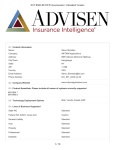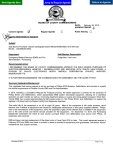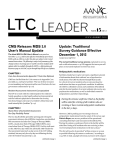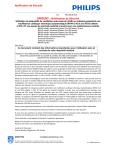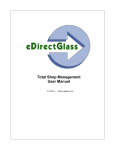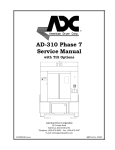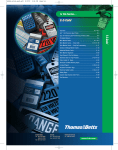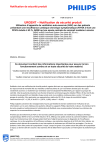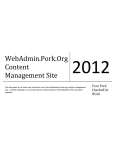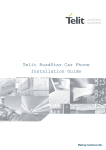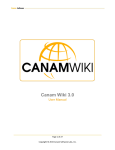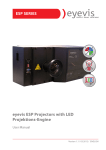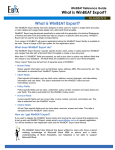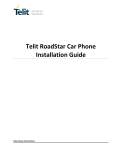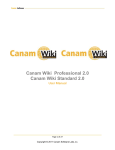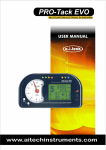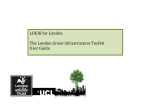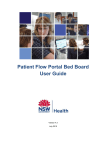Download 2015 RMIS Review Survey: Unbundled Vendor
Transcript
2015 RMIS REVIEW Questionnaire: Unbundled Vendors Q1: Contact Information Name: Brian Mack Company: Systema Software Address: 900 Larkspur Landing Circle Address 2: Suite 201 City/Town: Larkspur State: CA ZIP: 94939 Country: USA Email Address: [email protected] Phone Number: 800-272-9102 ext. 710 Q2: Company Website www.systemasoft.com Q3: Product NameNote: Please include all names of systems currently supported SIMS Claims Web: client hosted, Web: Vendor Hosted (ASP, Q4: Technology Deployment Options Web: Third party hosted (Public Cloud) 1 / 21 2015 RMIS REVIEW Questionnaire: Unbundled Vendors Q5: Lines of Business Supported State WC Standard Federal WC (USLH, Jones Act) Standard General Liability Standard Auto Standard Property Standard Professional Standard Disability Custom Q6: Other lines of business supported All P&C Lines can be supported. Member Portal, Reinsurance/Excess Q7: Other related functionality 2 / 21 2015 RMIS REVIEW Questionnaire: Unbundled Vendors Q8: Please describe your system’s document management capabilities. SIMS Claims provides a complete document management solution as part of the core application. SIMS Claims approach to Document Imaging combines steps to reduce data keying and the number of clicks a user needs to make to index an image to a claim file and process transaction information related to the image. SIMS Imaging workflow is configurable, and supports “out-of-the-box” the following workflow: 1. Sort paper documents into the following piles: • Medical Bills • Litigation Documents • Non Medical Invoices • Generic Documents (other than Litigation or Non Medical Invoices) 2. Medical Bills get shipped to Medical Bill Review provider to be scanned, indexed, and adjudicated. 3. Client prepares and scans litigation documents, non-medical invoices, and generic documents in separate batches, which place the images in different folders on a network drive. Any high-volume scanner with an auto page feeder that can acquire a .PDF file will do. 4. Data entry people work the following image queues separately: • Litigation Documents o Image is indexed to claim file o Events with a time/date are entered o Comments can be entered o An Image Attachment Description can be entered o Upon saving, the image gets routed to the Examiner/Adjuster’s Document Approval work queue • Non Medical Invoices o Image is indexed to the claim file o Payment data is entered, including selecting a vendor, pay code, invoice from-through date, amount, etc. o Payment comments can be entered o An attachment description can be entered o Upon saving, the Image gets routed to the Examiner/Adjuster’s Document Approval work queue • Generic Documents o Image is indexed to the Claim File and assigned an Attachment Type from a user definable drop down list o Upon saving, the image gets routed to the Examiner/Adjuster’s Document Approval work queue 5. Examiner/Adjuster’s Document Approval Work Queue • Litigation Documents o An examiner/adjuster can modify any of the data entered, Save and Approve the document, or Delete the document o Approval by examiner/adjuster puts an item on the Litigation Calendar and in Litigation Module of the Claim File • Non-Medical Invoices o An examiner/adjuster can modify any of the data entered, Save and Approve the document, or Delete the document o Approval by examiner/adjuster puts the invoice into the Supervisor’s Batch Payment Approval work queue and displays the payment in the Payments Module Grid on the claim file with an error flag set as Unapproved • Generic Documents o An examiner/adjuster can modify any of the data entered, Save and Approve the document, or Delete the document o Approval by examiner/adjuster puts the items on the Attachments Module of the Claim File 6. Supervisor’s Batch Payment Approval • Grid displays payment data and allows for selection of one or more payment for bulk approval/denial • Approval removes the payment from the Approval Grid and removes the error Flag for Approval on the Payment Module window of the claim file SIMS Claims also supports tight integration with third party document management systems (i.e Documentum, ImageRight, OnBase, etc.) 3 / 21 2015 RMIS REVIEW Questionnaire: Unbundled Vendors Yes, Q9: Do you provide user-defined fields? If Yes, are there any limitations on the number, field types or reporting capabilities on these fields? There are no limitations on these fields. Custom fields can easily be added in SIMS by users with the appropriate roles; custom fields are immediately available for reporting and business rules. Q10: Please identify all of the browsers supported by your system, including the earliest versions (i.e Internet Explorer 9) Currently, IE 8 and higher. We will have expanded browser compatibility available in May 2015, including Firefox, Chrome, and Safari. Q11: Please list the levels of hierarchy of your RMIS SIMS provides the ability to create an unlimited number of organizational tiers for an Insured so claims can be associated to regions, divisions, departments, etc. for reporting purposes. Each org tier will track fields such as: Org Code, Org Level Name, Location Number, Address, 3 Contacts including the contact information of phone number and e-mail address. This module will track changes made to org tier data including date when the change was made and user that made the change. Org Tree management provides drag and drop ability to consolidate levels and move org levels from one branch to another. PAGE 3: SYSTEM FUNCTIONALITY Q12: Dashboards and Alerts Configurable dashboard Standard Downloadable Standard Email alerts Standard Dashboard alerts Standard Clmt. Search from home page Standard Multi-level hierarchy Standard Multi-currency Custom Multi-lingual Custom Q13: Maximum amount of dashboards allowed by your system SIMS Dashboard comes pre-configured for each insurance line of business. Other dashboards could be added through configuration. 4 / 21 2015 RMIS REVIEW Questionnaire: Unbundled Vendors Q14: Please describe any unique dashboard or alert that we did not list above In addition to the standard dashborad capability SIMS Cliams provides integration to Microsoft Power BI which provides an ultimately flexible dashboarding capability and the use of natural language query. Q15: Standard Reports Scheduled reports with auto distribution Standard Report Bursting Standard Ad hoc reporting Standard “As of” date reporting Standard Searchable PDF reports Standard Download to Excel and PDF Standard Offline data manipulation allowed Standard Policy Erosion reports Configurable Loss triangles for data development and trending Standard Deductible reimbursement tracking Standard Profiling, red-flagging events Configurable Goal tracking Configurable Loss forecasting Configurable Experience Modification Configurable Cost of risk/premium allocation Configurable Underwriting/rating calculation Custom 5 / 21 2015 RMIS REVIEW Questionnaire: Unbundled Vendors Q16: Policy and Exposure Tracking Policy tracking (list of policies) Standard Policy management (details of policies) Standard Underwriting Unavailable Certificate tracking Unavailable Certificate issuance Unavailable Property tracking (values) Configurable Safety/loss control analysis Unavailable Bonds/contracts tracking Unavailable Asset Management Unavailable COPE Tracking Unavailable Fleet Management Unavailable Integrated Policy Management Custom Basic Values / Exposures Entry Unavailable Retention vs Premium Calculator Unavailable Coverage Gaps and Overlaps Custom Intelligent Mapping Standard Please explain your intelligent mapping software capabilities SIMS is integrated with Bing Maps to help adjusters quickly locate the claimant’s or incident address, and search for a specific type of business such as chiropractic practitioners or auto body repair shops within a user definable mile radius from the claimant’s address or accident location. Q17: Analytics & Metrics Analysis: Please describe any third party software used to perform business analytics Systema Software developed SIMS Insight as a tool to facilitate business analytics for our clients. SIMS insight capitalizes on Excel’s existing capabilities including Powerview to access data cubes and provide dynamic reports, data mining , and predictive models. Clients are able to pinpoint loss trends for risk management and to identify key drivers behind fraud, litigation, subrogation, and other costly claims exceptions. SIMS Claims also supports integration to Microsoft Power BI. In addition, SIMS Claims is an open system, and clients have the flexibility to use other third party products to perform business analytic. 6 / 21 2015 RMIS REVIEW Questionnaire: Unbundled Vendors Q18: Typical Analytics/Metrics reports Key Performance Indicators (KPI) measurements Standard Loss Forecasting Configurable Cost of risk allocation Configurable Heat Map reports on loss distribution/location Standard Other Key Reports SIMS Cliams come with a full array of standard reports that can be easilly modified. Q19: How, if at all, does your RMIS compare client data to non-client data? Systema does not provide non-client data for comparison purposes. However, if a client has access to industry data, that data could be housed in SIMS’ data warehouse and utilized for reporting purposes. Q20: Please describe any features or functions that are designed to support enterprise risk management processes: SIMS Claims flexible business rule engine can be configured to provide real time notifications of events that have been determined to support enterprise risk management processes. SIMS Claims Reporting system is also ultimately flexible to be able to extract and compile information needed for ERM. Q21: Please provide a list of current innovations that you are currently working on to deploy at a future date 1. Expand browser compatibility to include Chrome, Firefox, and Safari 2. Lien module 3. Chat module 4. Automated EDI (FROI/SROI) reporting 5. Continued integration with the Microsoft Office Suite Q22: Other notable features or comments SIMS Insight (BI and predictive analytics) Recognizing that business intelligence has the power to revolutionize the way the insurance industry analyzes data and forecasts trends, Systema Software developed SIMS Insight. This advanced business intelligence module is offered in conjunction with our flagship, SIMS Claims software. SIMS Insight delivers the information clients need—with greater speed and agility—to improve claim results, reduce program costs, and minimize future risk. This module will deliver effective “insight” for risk management organizations through its powerful capabilities and remarkable levels of performance. As a result, clients are able to: - Leverage data with greater speed and power. This module utilizes data cubes to pre-aggregate data into facts, dimensions, measures, and hierarchies, giving clients the ablity to generate reports at amazingly fast speeds. The data is rendered in multi-dimensional reports with flexible viewing capabilities. The result: clients are able to make more informed and strategic business decisions that give them an edge in the claims and risk management arena. - Identify and control cost drivers. SIMS Insight employs powerful data mining and predictive models to pinpoint loss trends for risk management, and to locate key drivers behind fraud, litigation, subrogation, and other costly claims exceptions. Claim departments can leverage these indicators to identify the cases most 7 / 21 2015 RMIS REVIEW Questionnaire: Unbundled Vendors other costly claims exceptions. Claim departments can leverage these indicators to identify the cases most likely to drive expenses, routing them to expert staff for proactive management and cost control. - Enhance client performance and results. With SIMS Insight, clients can essentially “drag and drop” new dimensions into their analysis, drill down or up in various hierarchies of information, and “slice and dice” data to find the kernels of business intelligence that will drive improved performance and results for their organization. - Save time and costs. SIMS Insight enables various dimensions (such as claims, policies, users, etc.) and facts of financial information (such as payments and reserves) to be used in analysis. Multi-dimensional reports with pre-aggregated totals allow our clients to instantly assess top-level metrics. It’s easy to aggregate financials by week, month, quarter or year—without having to define and generate new reports. As a result, what once took months or years to compile, analyze, and deduce—now takes a matter of seconds. Claim Summary SIMS provides an interactive graphical and intuitive summary upon first entering the claim file, pulling information from multiple places in the claim and displaying it in a single window. Information such as Policy, Deductible, Special Handling, Claimant Information, Financial Summary, Injury Information, and Plan of Action are displayed in summary form, providing the ability for adjusters/examiners to quickly re-familiarize themselves with a claim file when first opening the file. POA Plans of Action or POA’s traditionally are time consuming and can take a lot of work copying and pasting text from various parts of the claim file. SIMS POA Notepad Module eliminates copying, pasting, retyping, etc. and creates a “living” POA document. By using a combination of claim and client-defined fields, new POA’s can be created quickly by building upon previously entered information. Creating a New POA Notepad pulls information from other parts of the claim file displaying the information as read only, while providing the ability to edit or add to the content of other text entry fields. Once the changes have been made to the POA Notepad, users can Save and Preview their edits before publishing their changes to the Notepad. Once published, POA Notepads are stored with Standard Notepads in the Notepad Grid for viewing. In addition the latest POA Notepad is displayed in the Claim Summary (see image to the right) when a user first opens a claim file. This information will also be available for Reports that can be accessed by or distributed to the Insured/Policy Holder. The POA Template is completely configurable, providing the ability to determine the fields that will be pulled in automatically, and the data captured, leveraging memo fields, drop down lists, radio buttons, and date fields. In addition, claim files that have multiple Claimants per Occurrence/Incident can have claimant Notepads or Occurrence Level notepads that can be viewable from all Claimants associated with the Occurrence/Incident. PAGE 4: Claims Self Administration Features Q23: Please describe how your system develops a TCOR (total cost of risk) estimation SIMS does not develop a TCOR estimation, however SIMS extensive integration capabilities enable our clients to extract the claims data necessary to generate a TCOR estimation. 8 / 21 2015 RMIS REVIEW Questionnaire: Unbundled Vendors Q24: Please describe your business process / workflow collection tools SIMS Claims provides a completely flexible Business Rule Engine. Creating Rules in SIMS Claims will help drive best practices and workflow within an organization. SIMS Business Rules Module leverages Microsoft SQL Service Broker to provide a user friendly and intuitive construct for configuring both simple and complex rules. Simple rules are defined by selecting a table, one or more fields in the table, and the conditions of each field (if the field value is greater than, less than, equal to, between, etc.) that will trigger the rule. A single rule can be configured to perform an unlimited number of actions. Actions currently supported are: sending a diary, sending an e-mail, generating letters & forms, or entering data into a notepad. As an example, a Closing Claim rule can be configured so that if the Close Date is entered, the Claim Type equals Indemnity, the Loss Type equals Trauma, then send a Diary to the Supervisor, and send an e-mail to the Insured/Policy Holder. More complex rules involving more than one table can also be created using stored procedures. Both simple and complex rules are managed through the Business Rule user interface. • SIMS Business Rules run asynchronously so there is no negative performance impact upon saving a claim file, payment, etc.; this will allow SIMS to scale to a large number of users. • SIMS provides secure reserving and payment modules with easy to configure and automated authority level workflows Q25: Claims management features Customizable Diary Standard Adjuster Notes access (if applicable) Standard Reserve Analysis (worksheet) Standard 9 / 21 2015 RMIS REVIEW Questionnaire: Unbundled Vendors Q26: Claims administration features Incident Tracking Standard Check writing Standard Utilization review Unavailable Medical Bill Repricing Unavailable Transitional Work Management Standard Built-in Reserve Estimation Worksheets Custom Fraud Detection capability Standard Encryption of sensitive data Standard Subrogation & Salvage Tracking Standard Comprehensive Litigation Management Tracking Standard Adjuster Tracking/Performance Standard Other Claim Administration Features Many standard interfaces that support medical bill review, utilization review, pharmacy bills, ISO claim search. Check processing and printing is supported in addition to a complete payment processing workflow. There are many other features relating to claims administration that are too numerous for this forum. Q27: Third party reporting and documentation OSHA reporting Standard NCCI Reporting Standard 1099 Reporting Standard First Report of injury Standard FROI/SROI reporting Standard CMS reporting Standard EDI reporting Standard 10 / 21 2015 RMIS REVIEW Questionnaire: Unbundled Vendors Q28: Other notable features or comments 1. SIMS seamlessly interacts with MS Office products allowing information to be exported to Excel or Word with the simple click of a button. 2. The Litigation Module on the Claim File provides a place where examiners/adjusters can store information about litigation activities, recording the Type (Trial, Hearing, Deposition, etc.), Date, and Time of the activity. Litigation activities can easily be added to a user’s Outlook Calendar by clicking the Add to Outlook link provided. 3. The Attachments module is used for managing the large amount of documents created during the claim lifecycle. These can be electronically stored with the claim and retrieved whenever needed providing the ability to achieve a paperless claim environment. Most electronic media formats can be attached to a claim file. One or more Attachments can be associated with various transaction types, such as Diaries, Notepads, Payments, Litigation, or Contacts. 4. SIMS Email provides the ability to send email to and from the Claim File directly. SIMS’ Outlook add-in enables users to “copy” sent or received emails from their Outlook to a claim in SIMS. 5. SIMS is integrated with Bing Maps to help adjusters quickly locate the claimant’s address, and search for a specific type of business such as chiropractic practitioners or auto body repair shops within a user definable mile radius from the claimant’s address or accident location. 6. A unique differentiator for SIMS is its’ Automatic Subrogation feature, in which a client configured job identifies claims with subrogation potential based on injury/accident cause or description keywords. This job generates a subrogation record, flagging the file for potential subrogation. PAGE 5: Software, Technology and Security Q29: Did your organization develop the software platform your solution resides on? No Q30: If another organization develops the software platform your solution is based upon, please describe this relationship. SIMS Claims is a browser-based application developed using the Microsoft .NET platform, Web Services, C#, AJAX, and SQL Server. It can be deployed in a number of ways, but the most common involves the following components: • IIS Server hosting the presentation and business layers • SQL Server hosting the transactional database and business rules engine • Reporting Server hosting the SIMS Data Warehouse Additional servers can be added to this configuration: more than one IIS server or additional servers to split the presentation or business layer are common options. Q31: Who maintains your software platform? SIMS Claims is maintained by Systema personnel. Q32: What software is used to track your RMIS solution’s defects, bugs, and problems? Systema uses Desk.com for tracking defects, bugs, and problems. No Q33: Do you have a need to develop software outside of your primary platform? 11 / 21 2015 RMIS REVIEW Questionnaire: Unbundled Vendors Q34: If so, what applications are involved? N/A Q35: What third party vendors do you partner with to provide functionality? Systema does not partner with any third party vendors to provide functionality. Q36: Does your firm use off-shore resources at all? Yes, If yes, what company? We use a number of partners to outsource some services but would rather not name them in this forum. Q37: Who maintains your software infrastructure? For SIMS Cloud clients, Systema maintains the software infrastructure. The SIMS Cloud environments are hosted by Rackspace in a dedicated environment. For self-hosted clients, software infrastructure maintenance is our client's responsibility. Q38: Are there multiple, separate data center facilities used to host data for global clients? We do not have any global clients, but our SIMS Cloud offering includes primary and disaster recovery data center facilities. Q39: Do you provide the ISO 27001 certification to your clients? Yes Q40: Does your solution allow for full encryption at rest for all client data in all hosting facilities used by your organization? Yes Q41: Does your solution provide the ability to encrypt specific fields while at rest? Yes Q42: What technology/data standards are used/supported by your application? (e.g. WSI, WSS, ACCORD XML) ACORD, XML, SOAP Web Services Q43: Describe encryption protocols used within, and in communication with, the product. Encryption is up to our clients’ discretion; typically our clients choose to encrypt all data. Stored data can be encrypted at rest using Transparent Data Encryption. Individual fields within the database can be encrypted using any of SQL Server’s built-in encryption methods. We typically use Triple DES symmetric key encryption. 12 / 21 2015 RMIS REVIEW Questionnaire: Unbundled Vendors Q44: Describe any API offered We do not provide access to any API. However, SIMS has extensive integration capability for both importing and exporting data through SIMS Service Oriented Architecture. Multiple methods are employed for integration, including Web services, Database Views, XML, and Batch Import/Export. The SIMS Database is considered “Open” based on how the use of the SQL database has been deployed. SIMS is also deployed with a data warehouse that can be used for reporting, and as a data consolidation hub for interfacing so as not to over tax the live transactional database. In addition, SIMS has a number of prebuilt connectors that interface to many different systems (e.g. Medical Bill Review, Accounts Payable, etc.). Most connectors can interface with one or more vendor product. 13 / 21 2015 RMIS REVIEW Questionnaire: Unbundled Vendors Q45: CLIENT HOSTED DEPLOYMENTSMinimum recommended hardware requirements and any third party software licensing requirements Minimum Hardware and Software Requirements Minimum Desktop Requirements • Operating Systems: Windows XP, Windows 7 • Hardware: Recommended Specifications are: o Processor >= 2 GHz o RAM => 2 GB o Min. Resolution 1024 x 768 o Hard Drive Space Required <= 1 GB • Applications o Internet Explorer, IE 6 and higher (IE 8 is recommended) o Microsoft Word and Excel, version 2003 or later o Adobe Reader 9.2 or later Minimum Web Server Requirements • Operating Systems: Windows Server 2003 or above (Enterprise Edition is recommended) • Hardware: Recommended Specifications are: o Processor >= 2 GHz (minimum 2 processors recommended) o RAM >= 4 GB o Hard Drive Space Required < 10 GB • Software: o Adobe Reader 9.2 or later o Microsoft .Net Framework 3.5 and 4.5 Minimum Database Server • Operating System: Windows Server 2003 or above (Enterprise Edition is recommended) • MS SQL Server 2005 through 2014 (Enterprise version is recommended for improved scalability) • Hardware o Processor >= 2 GHz (minimum 4 processors recommended) o RAM >= 4 GB o Hard Drive Space Required >= 50 GB (depends on volume of data) Minimum Reporting Server Requirements (The Database Warehouse can also be deployed on this server) • Windows Server 2003 or higher (Enterprise Edition recommended) • SQL Server 2005 through 2014 (Enterprise Edition recommended) • Adobe Acrobat Reader 9.2 or later • Hardware o Processor >= 2 GHz (minimum 4 processors recommended) o RAM >= 4 GB o Hard Drive Space Required >= 50 GB (depends on volume of data) Printer (For Laser Check Issuance) • MICR Cartridge Compatible Printer Scanner (For Document Image Management) • Recommend a medium to high volume multipage feed scanner that can be configured place .PDF images in more than one folder on a network/PC NOTE: Document storage hard drive space requirements can be in excess of 200 GB depending upon the volume of documents when using SIMS built-in document management functionality. Q46: CLIENT HOSTED DEPLOYMENTSDoes the product support, and has it been tested with, virtualization software (VMware)? Yes 14 / 21 2015 RMIS REVIEW Questionnaire: Unbundled Vendors Q47: VENDOR or THIRD PARTY HOSTED DEPLOYMENTSSAS 70 audit (vendor/third party hosted versions only) Type II Q48: Does your company purchase cyber risk coverage to protect your clients' data assets? Yes Q49: Any additional comments related to software, technology and security Respondent skipped this question PAGE 6: Interfaces Q50: List standard insurer/TPA interfaces (in order of frequency) ISO Claim Search Connector CMS Connector EDI (FROI/SROI) Connector Medical Bill Review Connector Policy Administration Connector Document Imaging Connector Positive Pay Connector Accounts Payable Connector Pharmacy Benefit Manager Connector Human Resources Connector SIMS Claims also supports numerous data extracts to Insurers/TPA (i.e. AIG, Hartford, other) Q51: Please describe your approach to state EDI compliance (e.g. vendor partnerships) and the breadth of your existing capabilities. SIMS Claims offers several options for EDI that can be implemented independently or together as needed to meet each client’s requirements. Listed below are the different option: • Automated EDI Processing: Via an interface to and leveraging the EBIX WCIRS system, FROI and SROI transactions are automatically created based on data and transactions that occur in SIMS Claims. FROI and SROI events are then submitted to the applicable jurisdiction without the need for a claims examiner to create the transactions. • EDI-FROI/SROI Connector to a third party (i.e. EBIX, Mitchell, ISO, HealthTech, etc). FROI transactions are created automatically by SIMS Claims. SROI transactions are entered by the claims examiner into SIMS at the claim file level. FROI and SROI transactions are then extracted and sent to the third party for validation and submission to the applicable jurisdiction. • For California, SIMS provides EDI FROI/SROI functionality as a built in component of SIMS. FROI transactions are created automatically by SIMS Claims. SROI transactions are entered by the claims examiner into SIMS at the claim file level. FROI and SROI transactions are then extracted and sent directly to the State authority. No module, connector or transaction fees apply. 15 / 21 2015 RMIS REVIEW Questionnaire: Unbundled Vendors Q52: Other System interfaces User authentication (e.g. LDAP) Configurable HR Payroll Standard Accounting Standard External Document Management Services Standard External Bill Review Services Standard Q53: Other interfaces not listed above Claim Import Connector (FNOL), EBIX (Automated EDI FROI and SROI. Q54: What is your hourly rate for custom interface work? Our pricing approach to custom interfaces varies. It can be fixed fee or hourly. PAGE 7: Training, Support and Customer Feedback Q55: Briefly describe your standard training approach (when and to whom) and your methods utilized Training can range from on-site training, scheduled over a few days, where we directly train the organization’s employees, to a train-the-trainer plan where a number of individuals will deliver training to the rest of the users. We also offer online training for a cost-effective and flexible approach. Systema can provide training for up to 4 trainers at a time or up to 8 end users at a time. • User Training • System Administrator Training • Report Manager Training • Train the Trainer Training Q56: Number of staff dedicated to training and/or support 6 Toll free number, Q57: Support types offered: Dedicated (not pooled) support person, Online help, Print user manual Q58: Telephone support hours Monday through Friday, 5 am to 6 pm PST, excluding holidays. 16 / 21 2015 RMIS REVIEW Questionnaire: Unbundled Vendors Q59: Position regarding support of prior product versions Systema provides two new major releases of SIMS each year. New releases are not compulsory, however from a support standpoint, Systema only provides SIMS Claims support for up to 3 versions back or 24 months back from the current release, whichever is longer. Q60: Do you host a user conference? No Q61: What was the date of your last user conference? n/a Q62: How many customers / prospects were in attendance? n/a Q63: What other methods do you use to obtain customer and/or prospect feedback and input on feature priorities? We obtain feedback from the following sources: Account Management (i.e. current clients), Sales Process, Industry Events, Analyst Recommendations, SIMS Forum on Systema Service Desk PAGE 8: Implementation Q64: Describe your delivery team’s structure:Do you have a dedicated service team approach or does one account executive handle multiple responsibilities? Yes, Systema's dedicated project teams include a project manager, solutions architect, business analyst, data conversion specialist, and trainer; when possible, individuals that have one or more of these skill sets will be assigned to a project in order to reduce the number of people engaged on the project for more rapid deployment. Q65: Do you have dedicated business analysts? Yes. Q66: Describe your process of tracking delivery team activities To ensure regular and open communication between the clients and Systema project teams, weekly project management calls are required. The topics of the weekly meetings include: • Review Project Plan status • Review Project Log o Review Budget to Actual o New Risks? o Decisions taken? o Open Items status, owner, next steps and target date o Review/Confirm Priority and Ranking 17 / 21 2015 RMIS REVIEW Questionnaire: Unbundled Vendors Q67: Do you have a defined methodology for implementing projects? Systema has taken its agile software development approach and applied it to SIMS implementation. This iterative, incremental process enables Systema to expedite the delivery of client requirements while reducing the risk associated with project delays. As a result, many carrier clients confirm that implementations are completed on time, within budget, and represent the overall best value in the marketplace. Q68: Do you have a defined oversight or governance process for your implementations? Yes Q69: How long is the typical implementation time? Given the unique requirements of each client, the duration varies significantly from project to project, however a typical project implementation of SIMS Claims takes 6- 12 months from kickoff to go-live. PAGE 9: Business Information Q70: What was the year of your first RMIS implementation? 2006 Q71: Parent Company (if applicable) Respondent skipped this question Q72: Business Locations Headquarters: Larkspur, CA Other: San Ramon, CA Q73: Top Officers Top Executive 1: Jose Tribuzio Top Executive 2: Danny Smith Top Executive 3: Brian Mack Q74: Number of employees (RMIS division only) in 2013 Executives / Senior Management 2 Product Management, Marketing & Sales 5 Project Management, Development and Quality Assurance 5 Customer Support and Training 1 Total Employees 13 18 / 21 2015 RMIS REVIEW Questionnaire: Unbundled Vendors Q75: Number of employees (RMIS division only) in 2014 Executives / Senior Management 3 Product Management, Marketing & Sales 5 Project Management, Development and Quality Assurance 22 Customer Support and Training 5 Total Employees 35 Q76: Total annual revenue for all product versions offered Decline to provide information Q77: Approximate percent of revenue spent on R&D Decline to provide information Q78: Customer Statistics Total Current Parent Level Clients –this client version 15 Total Current Parent level Clients- all previous versions 21 Total Current Users—all versions 1992 New Clients in Last Fiscal Year 15 Largest Number of Users in Single Contract 500 Number of lost clients in Last Fiscal Year 0 Q79: Largest customer markets (Please rank top 5) Energy 4 Insurers/TPAs 1 Pools/Self-Insured Groups 2 Other (please specify) Insurance Carrier would be #3 Q80: Please rank order how you obtain most new accounts (unbundled systems only) Competitive RFPs 1 Sole source (no competition) 2 Client merger/acquisition 3 Q81: Top 5 RMIS competitors 1. Guidewire 2. Origami 3. CS Stars 4. Ventiv 5. Accenture 19 / 21 2015 RMIS REVIEW Questionnaire: Unbundled Vendors Q82: Predominant programming language .Net / C# Q83: Databases supported Microsoft SQL Server Q84: Please identify all mobile devices that can be used by your system Mobile devices that run on iOS or Android environments Q85: Please list the RMIS-related revenue for the following years: 2013 Decline to provide information 2014 Decline to provide information Q86: Please identify all revenue-generating activities: Software license sales, Custom applications, Data Conversion and Consolidation activities , Consulting, Ongoing maintenance Q87: Please indicate the percentage of revenue derived from these activities: Software license sales Decline to provide information Custom applications Decline to provide information Data Conversion and Consolidation activities Decline to provide information Consulting Decline to provide information Ongoing maintenance Decline to provide information Q88: Does your RMIS act as a “channel partner” for any 3rd party information or a la carte services? Yes, PAGE 10: Pricing 20 / 21 If yes, please describe and include additional pricing information if relevant. New automated EDI (FROI and SROI) reporting for state compliance. Transaction fees are volume based. 2015 RMIS REVIEW Questionnaire: Unbundled Vendors Q89: Pricing approach for ongoing usage (check all components that drive cost for client; do not check if no charges associated) Site license, Module/LOB pricing, Non-named users (concurrent usage), Data conversions/feeds/EDI, Maintenance, Support, Training, Integration with HR, A/P systems, Other (please specify) Systema adheres to a concurrent user license model; named users is not an available option. With respect to read only users, an unlimited number can be added at no additional cost to our clients. Respondent skipped this question Q90: Approximate total annual cost (ranges) excluding initial implementation Q91: What are the associated fees and hourly rates to implement your system? Our fees and hourly rates are extremely competitive, however we would prefer not to provide specifics at this time. Q92: What is the typical one-time cost to implement your system? These cost can vary dramatically. More detail on the scope of an implementation is needed to provide this information. Q93: Additional comments on pricing Systema offers both perpetual and term licensing models. PAGE 11: Other Information Q94: Please comment on your recent system uptime/availability performance, as well as methods that you use to measure and monitor it. SIMS Cloud guarantees a 100% uptime during our support window. The Nimbus platform is used as the main method for monitoring. Q95: Please describe if your RMIS is multilingual.If so, please list the other languages supported. The system is not multilingual. Q96: List the top 3 reasons that you believe set you apart from other RMIS vendors 1 Out-of-the-box features 2 Ease of configuration 3 Superior support 21 / 21






















